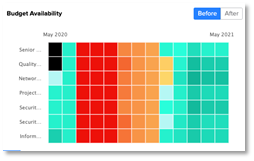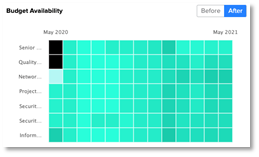Trying to debottleneck a Portfolio Plan can be difficult undertaking as shifting one project to fix a Cost Field and Time Period could cause problems in another. The Decision Lens Bottleneck Analysis helps Portfolio Owners by providing recommendations as to an optimal plan to debottleneck.
These recommendations will be made on the scheduled projects within the plan to provide a set of recommended moves that will best debottleneck the Plan. The algorithms will ignore any In-Progress projects as well as projects that are locked.
The Bottleneck Analysis Recommendations are generated using genetic algorithms that look through the possible combinations of scheduling options to try and identify an optimal solution. The algorithm will attempt to debottleneck the Plan by balancing:
- Minimizing budget availability
- Minimizing the number of projects to move
- Attempting to do the most valuable projects earliest
The recommendations are listed display the name of the project as well as the current timing and suggested timing as well as the delta in months. Where possible the Bottleneck Analysis recommendation engine will attempt to shift projects to stay within the analysis horizon specified however, when there is no possible answer to debottleneck within tolerances, the application can suggest to move projects outside of the timeframe. Grey background arrows will denote shifts earlier in time (left facing arrow) and further out in time (right facing arrow) while staying within the analysis horizon. Red background arrows denote recommended schedule changes that require pushing Projects outside of the Analysis Horizon.
The heatmap displays the current state of a given Plan and associated Budget Availability as the “Before” state. Clicking “After” will display the resulting Budget Availability levels if recommendations are taken.


Note that where there are overconstraints that are denoted in black (where there are currently more locked and in-progress allocations than available budget, the recommendations will attempt to debottleneck as best as possible even though it would not be able to fully resolve all overruns. In this situation, a message will be displayed to the user to alert them of this situation.

When the Bottleneck Analysis is used while in the Baseline Plan, a what-if plan must first be created before applying recommendations. When using the Bottleneck Analysis while in a what-if Plan, recommendations can be taken within that Plan itself.